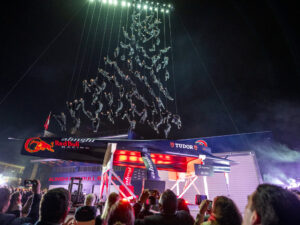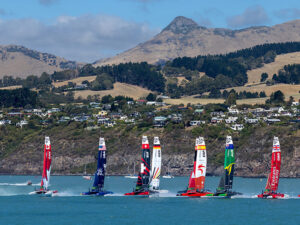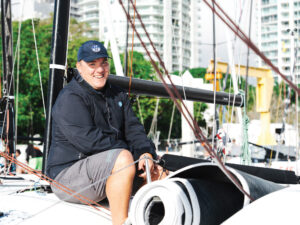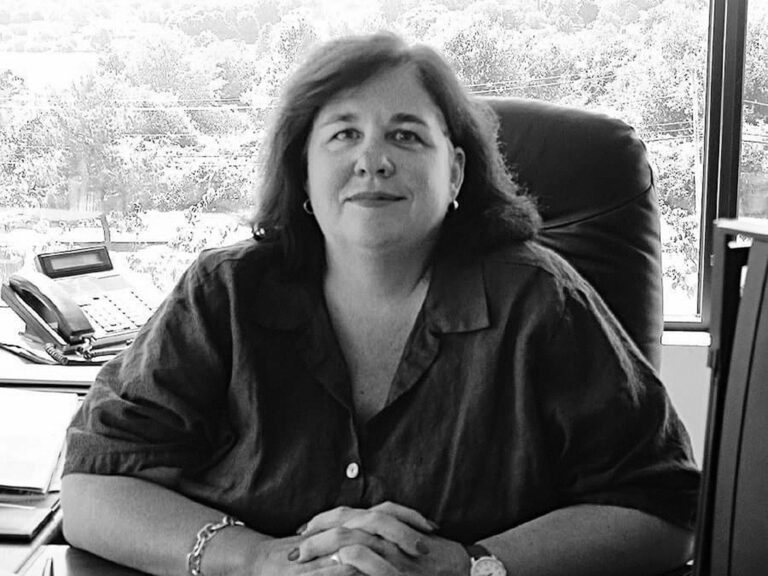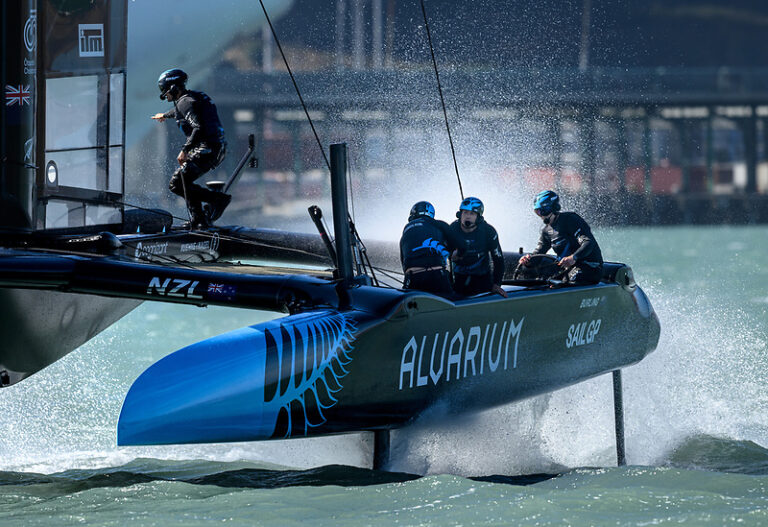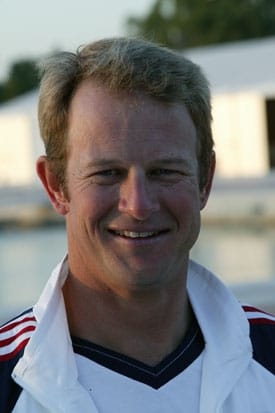
OgletreeSt
Old dogs can learn new tricks, or at least that’s what John Lovell and Charlie Ogletree are hoping. In the midst of their fourth Olympic campaign, the 39-year-old Tornado veterans are faced with the challenge of adapting to the class’ new carbon rig. “After sailing with the aluminum rig for so long, this is like starting from ground zero,” said Ogletree, who has been crewing for Lovell since 1993.The 27th place finish the pair posted at the recent Tornado World Championships in Argentina served as a wake-up call that the competition has caught up since 2004, when Lovell and Ogletree won silver at the Athens Olympics. Still, nobody’s counting them out for 2008. Before the disappointing Worlds finish, Lovell and Ogletree had been sailing well, placing first at the Miami OCR in January, fourth at the Good Luck Beijing-2006 Qingdao International Regatta in August, and first at the US Sailing Pre-Trials in October. In a recent interview with Sailing World, Ogletree spoke openly about his team’s strengths and weaknesses, the state of Olympic campaign funding, and the abundance of volunteer labor in China.Before the 2004 Olympics, you hinted that it was your last campaign. At what point did you decide to have another go at it? We had a successful run in Athens. After that, we looked at our whole program and decided we had a chance to win again. Plus, we were lucky enough to secure good sponsors, which makes it much more viable. A lot of that decision is financial. It takes money and commitment to do an Olympic campaign. Plus, we have some unfinished business. We came close to gold in Athens. Obviously we were happy with silver, but Your Worlds finish wasn’t as high as you might have liked. How would you asses the year on the whole?We did have a good year. We started out by winning the Miami OCR by 26 points. It was an incredible event, and everything was working really good. The Worlds was our first bad regatta, really.What went wrong there? A couple of things happened. First, because of our funding situation, we have never been able to practice ful-time until the last two years leading up to the games. Over the past two years the full-time teams from other countries with government funding and sponsorships have gained a leg up just by spending more time on the water. We’ve just been going to regattas with no training in between. The other teams are just catching up with us. We’ve been able to get by on sailing well, but not practicing has allowed other teams to catch up. Also, the carbon-rig rule has had an effect. The new carbon rig is totally different than the aluminum mast we used last year. We took at crack at designing a sail for the carbon rig, and we’ve been happy with that design. But since Miami last January the guys who’ve been working full-time with the new sails and rigs have made a huge leap. In what ways does the carbon rig perform differently than the aluminum rig? The carbon rig is twice as stiff as the aluminum one, which changes not only the way the mast bends out on the water, but the trim, the tuning, and the design of the sails. Something has to give, something has to flex with changes in the wind. With aluminum, you can make a stiff sail and the mast will flex, it’s more forgiving. With carbon, because it’s so stiff, it’s less forgiving, and you have to build that flex into the sail. It takes a lot of time and testing to figure out how it works, and we’ve neglected to spend that time in testing. The effects of the carbon rig have come about so quickly. I mean, we’re sailing the same boat we used in Miami, against the same people, and there hasn’t been much change on our end. Yet we’ve gone from being one of the top teams to getting hammered by the competition. Tell me about the funding situation for U.S. sailors.First, there’s a grant you get for making the U.S. Sailing Team, which you do by being in the top three after the Pre-Trials, the Miami OCR in January, and the North Americans in February. There’s a small grant for one, two, and three. It’s not a lot of money, certainly nothing in the six figure range, but it’s enough to get you started. On top of that, the U.S. Olympic Committee, which is separate from US SAILING, offers different categories of grants based on performance and previous performance. Because we won silver in Athens we’re eligible for grants that others aren’t eligible for. There are three levels of funding with different criteria to meet. If you’re ranked in the top ten in the world, that’s one, if you finish in the top ten at a world championship, that’s another, if you’re ranked first in the U.S., that’s another. There are seven criteria and we try to hit at least five of those. A lot of the grants tend to look at your past performance, not the present. And a lot of the money that goes to the different sports is based on how the sport did in the last Olympics. If sailing won zero medals in Athens, for instance, the USOC wouldn’t give sailors any grants for the next Olympics.In that way, do the rich just get richer?For sure. The USOC doesn’t care about the distant future. They care about now and four years from now. Right now, it’s only China, not 2012 or 2016. They rely on the NGBs-national governing bodies, like US SAILING-to raise money for development.How does your team’s funding break down?We have sponsorship funding from Advanced Equities, an investment firm in Chicago, we have a small grant from US SAILING, and there’s some USOC money, which is fairly small. And then we’re doing something interesting for this next Olympics: We’ve taken on John Bertrand as our fundraising campaign manager and we’ve coupled with another American Tornado team, Donald Thinschmidt and Drew Wierda. They’re 19-years-old, they’re the futureAs you get older, you want to help out the younger people in the class. The deal is that we bring [Thinschmidt and Wierda] along and teach them all we know. They train with us and our European training partners, and they help us with money. They come from sort of a connected family, so there’s sort of an arrangement there. We’re calling the program T2 Racing. Nice. Are you all big Schwarzenegger fans or something?Actually, it’s called “T2” because there are two teams and we’re sailing Tornadoes. It sounds like a great program. It’s nice to see American teams working together for a change.It’s sort of based on the French model. France had three teams in the top ten at the Worlds. The reason the French are so successful is because they have full government funding for the four or five top teams. It doesn’t matter if you won a medal at the last Olympics, or if you’re ranked fourth-you all train together. They still have incentives for finishing well at the Worlds or the European Championships, but each sailor gets a salary to sail. It really helps in the interim between the Olympics. From what you’ve been saying, it seems like there’s a lot more to Olympic success than sailing ability.Certainly. It takes all aspects. You’ve got to have the sailing ability to win the trials, but you also have to have the best equipment possible, you have to have invested the time to perfect your skills, and of course you have to have money. Both Johnny and I have other jobs and bills to pay. I work full time for Ullman Sails, Johnny is an accountant with his family’s business, Lovell and Company.What’s your plan for the immediate future? We’re going to put more time into campaigning pretty full-on. We’ve got nothing until Miami on January 13, and we’ll be sailing in to February with the North Americans. We’ll be in Europe for March, April, through the end of May. We’ll be in China in August, then there’s the qualifiers in October. Hopefully by the time that’s finished we’ll be leading the selections. How did you like the conditions in Qingdao? Is it a suitable Olympic venue?I think the venue is incredible. They’re so far ahead of the previous Olympic venues I’ve been involved with in terms of being prepared. There’s the Pre-Olympics coming up in 2007, and this year’s event was more like a pre-Pre-Olympics. It was probably more organized than any Pre-Olympics I’ve been to. There was an opening ceremony with fireworks and security and everything. Everything’s finished. It’s phenomenal. There’s plenty of volunteers, of course, because you know there’s no shortage of people in China. Those are the positives. The negatives are the actual sailing conditions. The water is nasty. It’s the worst place I’ve been in terms of water quality. All the raw sewage pumps right into where you sail. It’s a genuine concern. You’ve got to take care of your cuts every night to make sure they don’t get infected. It could be a real challenge to keep from getting sick over there. As far as the wind conditions, everything you’ve read is true. Last summer, only three of the ten races we sailed were in more than six knots. So have you been forcing yourselves to practice in light air?That’s the thing. If you love sailing, you normally don’t go out if there’s no wind. But we’ve been making ourselves go out in stuff that we wouldn’t have sailed in before. There’s a huge difference in sail design and how you set the boat up for light air. A sail that works in zero to six is different than a sail that works in medium to strong winds. Eight to ten is a windy day in China. What aspects of your sailing have you been working on?Our main weakness is lack of time. It’s no secret that practice pays. The more hours you spend on the water, the smoother, faster, and easier things become. Usually, by the end of an event we feel like we’re just hitting our stride, so hope to get in a lot more practice over the next two years.


